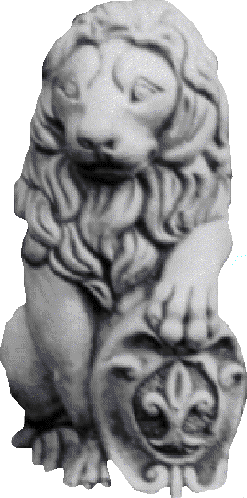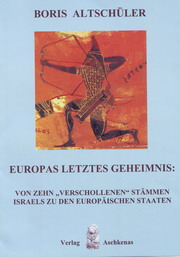
Startseite
Skythischer Verlag
 Bücher Bücher
Die Aschkenasim Partner
|

Boris Altschüler

Boris Altschüler
Europas letztes Geheimnis:
Von zehn "verschollenen"
Stämmen Israels zu den europäischen Staaten
ISBN 978-3-9803917-7-1
EUROPE'S LAST SECRET:
FROM TEN "LOST" TRIBES OF ISRAEL TO EUROPEAN STATES
About the "Japhetitic theory" of Nikolay Marr,
the proto-matrix-language and the ethnolexical developments
of the European ethnogenesis
Verlag Aschkenas
Who were the Scythians?
More than three thousand years ago, the first deportations of
the ten Israelite-Canaanite tribes of Eretz Israel from northern
Palestine took place. The hypothesis (concerning the lexis)
of this paper has been adequately inferred by the creator of
the "Japhetitic Theory", an excellent Russian linguist
and philologist of the 20th century Nikolay Marr (1865-1934).
Their emigration route mainly led them over the ancient Asia
Minor, Caucasus and also through Central Asia into the Great
Eurasian Steppe. These people spread the archaic Semitic world
language across the northern Barbaricum. The Hebrew-Canaanite
language, called Lashon Canaan, can be regarded as a unique
of an Israelite-Punic super-ethnosis. The Canaanite language
became the proto-matrix of the European languages. It determined
the further ethnolinguistic development of both Eastern Europe
and Western Europe.
The historic-etymological analysis is of the process of migration
of a Semitic-speaking ethnicity to Eastern, South East, Northern
and Central Europe, which had been divided several times over
the millennia into many tribes. Peoples of Europe prove these
tribes disappeared gradually and later re-established. This
method permits us among others to clarify the beginnings of
many European nations, which had a common field concerning the
lexis in archaic times and which kept the most important fragments
of the relict-Canaanite language until today.
The expansion of the migration of the peoples of the Israelite
Scythians, Sarmatians, Suebi, Goths, Almani/Alamanni, Huns,
Franks, Avars, Khazars, Bulgarians, Vikings, Rus, and also the
'Turk' peoples from the Avarian and Khazarian Khaganates provides
a clear ethnolinguistic proof for this. This proof is mainly
delivered by language analysis and onomastics.
Alltogether of more than 700 ethnonyms, toponyms, hydronyms
and oronyms, of the names of socialy important people or deities,
which kept their old Semitic nature over thousands of years,
have been examined palaeontological and in terms of their etymology.
Numerous translations from the ancient Semitic-Canaanite languages
allow us to understand the sense of many historic-ethnic situations
in Eastern and Western Europe. Merely the reverend doctrine
of the Anglo-Israelism from the middle of the 17th century maintained
the historical memory of this process. In Russia Hebrew-Canaanite
had been spoken until the beginning of the 20th century. In
Germany expeditions of linguists discovered in the second half
of the 20th century villages in the Eifel (for example the village
Nerot - Hebrew: The Candles), where virtually whole sentences
in Hebrew have been carried on in dialect, like the legendary
"Der Sus ist toff bei der Maloche" (The horse is good
at work).
The European, Christian development had a massive influence
through the Imperial Church and its medium, Latin including
vulgar Latin and Greek, and also through the Celtic languages.
Under this influence, the languages of the new states and peoples
were developing. One can state that during the first millennium
AD, Europe besides Latin and Greek also spoke Hebrew-Canaanite.
Approximately between the 11th and 15th centuries, the new national
mixed languages have increasingly established and further developed
their current forms throughout the modern age. Driven by continuous
acculturation, assimilation and exchange of languages the identity
of the European and Asian Israelites changed. These changes
characterised the new European and Eurasian ethnogeneses.
|


 Bücher
Bücher